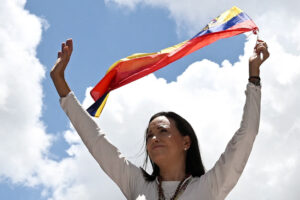
At a moment when political polarization threatens productive dialogue across campuses and beyond, how can universities create space for meaningful exchange between people who disagree?
SNF Agora Institute faculty members Andrew Perrin, Amy Binder, and Steven Teles may have found one way.
Together, they designed a face-to-face gathering intentionally structured to bring together participants across a wide range of political and intellectual perspectives. They submitted the idea to Johns Hopkins University’s Nexus Awards program. The result was Democracy and the Academy: Critics and Defenders, a convening held May 27-29 at the Hopkins Bloomberg Center in Washington, D.C., where 36 critics, defenders, and practitioners of higher education stepped into a room to try something different: listen to each other.
Before the meeting, each participant submitted a memo outlining what they saw as the most significant challenges and greatest successes in higher education. Organizers distributed the memos in advance, then selected specific pairs to kick off each session. The contrasts surfaced core tensions and opened space for pluralism.
The structure of the day pushed people to participate. Each session opened with 10 minutes of remarks, followed by 75 minutes of discussion. There were no cameras, recordings, or online commentary.
The convening was one of 40 Nexus-funded projects, part of a university-wide effort to support public dialogue at Johns Hopkins’s Washington campus. The organizers constructed the participant list with careful attention to ideological diversity, ensuring that people could participate fully, not as tokens of one side or the other. Everyone spoke at least once. Many of the participants had never spoken face-to-face with the very people they had publicly criticized.
Without the pressure to perform for a public audience, the tone changed. People still disagreed; some strongly. But they stayed in the room. They listened. They asked follow-up questions. They adjusted. No one needed to prove their tribe right; the environment didn’t reward that.
The in-person gathering revealed complexities that online debates obscure. A DEI officer voiced critiques of existing DEI practices. A senior academic official made some of the meeting’s harshest critiques of higher education. Teles observed that people’s institutional roles didn’t predict their views.
Other moments cut deeper. One participant, in conversation with Amy Binder during a break, misread a passing comment as a political critique. Binder caught herself. “Her starting place wasn’t the same as mine,” she said. “I realized—oh, that’s right. We invited people who come at these topics from very different starting points.”
Those divergent starting points didn’t cancel the conversation. They gave it shape. One participant expressed frustration with syllabi that omitted key thinkers due to political reasons. Another challenged that framing, arguing that inclusion without reflection can re-center ideas that never deserved the spotlight in the first place. The disagreement deepened, inviting dialogue rather than collapsing the discussions into slogans.
The conversations extended beyond formal sessions. Binder described how shared meals created connections. Without assigned seating, people had to find each other, building relationships that make difficult conversations possible. She later reflected on how the space worked. People didn’t hedge, but they also didn’t deliver polemics. The format, balance, and expectation of seriousness encouraged people to talk like adults rather than avatars. When participants were no longer the only representative of their position, they engaged differently. They asked questions. They shared stories. They stopped defending and started exploring.
The conveners expected strong views. What surprised them were the emails afterward. “Everyone left the conversation much more jazzed than I expected they would be,” Perrin said. Some called it a triumph. Others said they hadn’t been in a space like that before. It felt rare. It felt useful.
What happened that day won’t end the culture wars on campus or resolve every concern about bias, inclusion, or academic freedom. It created conditions where people with differing views could sit together, speak freely, and stay long enough to hear one another out. Most of our platforms for public conversations reward speed and “engagement,” however vitriolic that engagement may be. This one rewarded presence. And in a time when so many doors feel closed, this gathering left one open.

